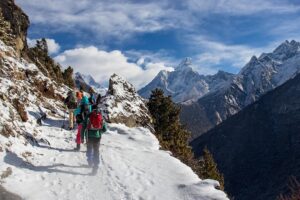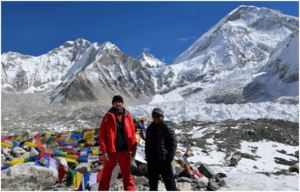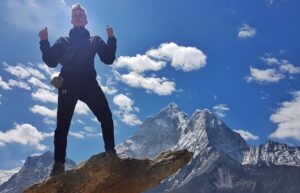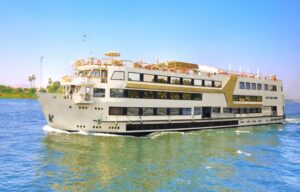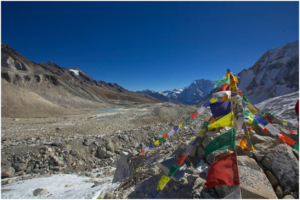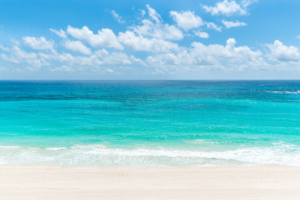The Ultimate Trek Everest Three High Passes with a Sherpa Expedition

One of the most adventurous and hard treks in the world!🥾 The Everest Three High Passes Trek is a great way to explore the remote place of the eastern Himalayas in excellent Himalayan terrain as well as crossing three high-altitude passes: Kongma La, Cho La, and Renjo La. This trek really pushes trekkers to their limits both physically and mentally, as they forge their way up steep ascents, over rocky terrain, and along icy stretches, while soaking up some of the world’s most stunning views — including panoramic views of Mount Everest, Lhotse, Makalu, and numerous other soaring peaks.
Everest Three Pass Trek 2025 What really sets this trek apart is trekking alongside Sherpa guides who have been navigating the famous trails for generations, giving them a deeper understanding of the region that transforms the experience into an unforgettable journey. The Sherpas, native to the Khumbu region, are skilled mountaineers, and their local knowledge and adaptability to the high-climbing terrain make them crucial for a successful journey. They lead hikers through the extremely difficult terrain, administering proper acclimatization to reduce the threat of altitude sickness, which poses a significant danger at such high altitudes.
Among their valuable experience, Sherpas provide a spiritual and cultural element to the trek, which allows trekkers to explore the unique traditions and customs of the Sherpa people. Along the way, trekkers stop in remote villages, Buddhist monasteries, and stupa sites, gaining insights into the Sherpa’s relationship with the mountains and their deep respect for the natural world.
This hike is not only about reaching the pass, where the real reward is a feeling of true accomplishment for hiking to such great heights and a completely different aspect of the Himalayas. From seasoned hikers to first-time adventurers, the Everest Three High Passes with a Sherpa expedition offers a bucket-list journey of stunning vistas, rich culture, and immense accomplishment.
The Everest Three High Passes Trek Overview
Everest Three High Passes Trek is an adventurous trek in the amazing Everest area with some demanding and gratifying terrain. This walk features some of the most stunning views in the world, the chance to cross 3 high-altitude passes (Kongma La, Cho La, and Renjo La) and, as the name implies, the remoter and less-frequently traveled route, providing plenty of peace away, for example, from the Everest Base Camp walk which is among the busiest in the world. They all cross over 5,000 meters but are not just physical challenges; they also offer some of the finest sights in the world, including Mount Everest, Lhotse, Makalu, and Cho Oyu. During the 18-21 days of trekking, they will pass rocky trails, glaciers, and valleys, enjoying the natural beauty of the Himalayas while experiencing Sherpa culture in tiny villages that dot the landscape. This is the right trekking trail for any expert camper who is keen to achieve the perfect blend of adventure, high-altitude disturbances, and cultural exposure. Not for the faint of heart, the Everest Three High Passes Trek needs preparation, planning, and acclimatization, but you can expect a great sense of accomplishment and stunning views that make all the effort worthwhile: it’s the experience of a lifetime.
What Makes a Sherpa Guided Trek Stand Out?
Everest High Passes Trek price A Sherpa-led expedition for the Everest Three High Passes Trek is a vital component to guarantee safety, success, and a rewarding experience. Sherpas are local people from the area around Everest, which makes them the most experienced and knowledgeable guides to trek through the harsh and remote terrain. This intimate knowledge of the Everest region’s trails, weather patterns, and the effects of high altitude minimizes risk and smooths the journey. Sherpas are masters at navigating the obstacles on the high-altitude passes and have more experience in helping trekkers adjust to the conditions, avoid altitude sickness, and rescue those in trouble, if the need arises. In addition to their technical ability, Sherpas also serve as cultural ambassadors, providing insight into the region’s history, its Buddhist traditions, and the lifestyle unique to the Khumbu Valley. They not only guide, but also plan logistics — food, safety, comfort, and supplies. The presence of a Sherpa guide can make the trek much more personal and, frankly, rewarding. They know how to make trekkers feel comfortable and supported in tough conditions, and their familiarity with local customs and traditions makes for an authentic cultural exchange. With a Sherpa at your side, consider the Everest Three High Passes Trek a safe and unforgettable experience.
Aspiring for the Ultimate Quest
The Everest Three High Passes Trek preparation involves both physical training as well as planning. It’s a challenging high-altitude trek, so be in top shape before attempting to travel this route. Aerobic endurance is key because the trek features long days of walking and crossing technical high-altitude passes. Training should consist of activities such as hiking, running, cycling, or swimming to develop endurance. Building strength in the legs, core, and upper body will improve stability and endurance on steep, rocky trails. Preparation with your mind is just as important. The climb can be psychologically demanding, especially during inclement conditions or heavy travel with difficult terrain. This is the most crucial aspect of this entire endeavor that has very little to do with the aforementioned physical aspects — mental preparedness. When it comes to gear, the right equipment is essential. Having sturdy, well-fitted trekking boots is a must to ensure comfort and support when hiking on rugged trails. A good layering system is necessary and the temperatures can vary widely. A good sleeping bag rated for cold weather, a lightweight yet durable backpack, trekking poles, and high-quality rain gear are must-haves. Remember to bring essentials, like sunscreen, a headlamp, and a water filter. You’ll also have to obtain the permits you’ll need, such as a TIMS card and a Sagarmatha National Park permit. Make sure to also figure out how to get to and from Kathmandu as well as book with a well-rated Sherpa-led expedition team that will safely guide you through the trek.
A Brief Summary of the Three High Passes
Everest Three Passes trek vs base camp Extending from Everest base camp to reach the summit, the Everest Three High Passes trek is a test of endurance as well as offering trekkers unrivaled views across the world’s highest mountains over three major high-altitude passes: Kongma La; Cho La; and Renjo La Kongma La (5,535 meters / 18,159 feet) is the highest of the three passes and perhaps the most physically demanding. It is a challenging ascent and rocky approach but a reward for trekkers with brilliant views of Mount Everest, Lhotse Makalu, and Cho Oyu. The second pass, Cho La (5,420 meters / 17,782 feet), is famous for its glacier and technical trail, with trekkers crossing ice and narrow ridges. The pass offers stunning views of the Khumbu glacier and surrounding mountains. The third, Renjo La (5,360 meters / 17,585 feet), is a relatively quieter, less trafficked route. Renjo La is the least challenging of the three passes, yet still offers great views of Everest, Cho Oyu, and Makalu. During leaping through these passes some beautiful Sherpa villages, Buddhist monasteries, and stunning Alpine lakes are crossed adding a variety of culture in addition to a physical challenge. This pass is unique from the others for a variety of reasons; be it the scenic beauty from the top, the exhilaration of climbing a high pass, or escaping the crowds of the other passes in the pristine solitude of Renjo La. I think with the necessary perseverance any healthy person can do this trek and all other high-altitude trekking, given that you are acclimatizing properly.
Management of the trek itinerary and highlights
This trek covers the Everest Three High Passes Trek which is an adventure spanning 18-21 days traversing through some of the most dramatic landscapes, remote villages, and the heart of the Everest region. Here is a broad draft of the itinerary:
Day 1: Fly from Kathmandu to Lukla (2,840 meters), then trek to Phakding (2,610 meters).
Day 2: Walk to Namche Bazaar (3,440 meters): the gateway to the Everest area.
Day 3: Acclimatization day in Namche, optional short hike to Everest View Hotel for mountain view.
Day 4: Climb to Tengboche (3,870 meters), where the famous Tengboche Monastery is located.
Day 5: Trek to Dingboche (4,410 meters), with an acclimatization day to help your body adjust to the altitude.
Day 6: Rest day in Dingboche for acclimatization.
Day 7:Trek to Lobuche (4,940 meters)
Day 8: Acclimatization day at Lobuche.
Day 9: Over Kongma La Pass (5,535 meters) and down to Dzongla (4,830 meters).
Day 10: Hike to Gokyo (4,790 meters) via Cho La Pass (5,420 meters).
Day 11: Acclimatization day in Gokyo to climb Gokyo Lakes and observe beautiful views of Everest.
Day 12: Cross Renjo La Pass (5,360 meters) & Descend to Thame (3,820 meters)
Day 13: Trek to Namche (after lunch)
Day 14: Trek back to Lukla.
Day 15: Return to Kathmandu by air.
Trekking ItineraryItinerary -8 DaysKathmandu and PokharaArrange acclimatization days on the trekIn the body of the trek, acclimatization days to help you adapt to the growing height are merged. These rest days are necessary to acclimatize and are critical for avoiding altitude sickness, and to make sure you’re fit for the tougher passes. TOPIC: EPIC TREK BITI - FATTERN YOURSELF IN NATURE & SPIRITUAL WORLD OF Everest region Throughout the journey, there are several things to see for breathtaking photography, local sherpa culture, and the Himalaya environment.
Acclimatization & High Altitude Tips
Everest Three Pass trek elevation One of the most important considerations during the Everest Three High Passes Trek is acclimatization. Proper acclimatization is required along this hike as high-altitude passes above 5,000 meters must be crossed to avoid altitude sickness which can lead to death if not treated timely. The general rule of thumb is to gain elevation during the day and sleep at a lower elevation to give your body a chance to acclimatize. Strategically customized rest days (e.g. Namche Bazaar, Dingboche, Gokyo) are sprinkled throughout the trek to allow your body to adjust to the higher elevation. Symptoms of altitude sickness are headache, dizziness, nausea, and shortness of breath. If this happens, it’s important to go down to a lower altitude right away. The next important tip — walk slowly and steadily through the trek. This allows your body to acclimatize slowly to the rarer air. Hydration is also key at high altitudes, as dehydration can worsen all symptoms of altitude sickness. Stay well-hydrated, and if necessary, refrain from using alcohol or cigarettes, which raise the risk of altitude-related complications. Also, eat a balanced diet with plenty of carbohydrates and essential nutrients to stay energized. Also, carrying medicines like Diamox (on a doctor’s prescription) will help with altitude sickness. And finally, listen to your body; if you are feeling under the weather don’t overdo it. If you are interested in doing the trek without problems healthwise then the best bet is to emphasize your acclimatization.
Expedition Specific Gear Needed
The perfect itinerary of packing for Everest Three High Passes Trek is affected by the terrain and prerequisites of the excursion. Proper footwear is paramount. Trekking boots should be sturdy with ample ankle support, waterproof (or water resistant), and have a firm sole for rocky paths, snow, and icy sections you may encounter. The key to staying comfortable in the fluctuating conditions is layering. A moisture-wicking base layer allows sweat to escape, and an insulating mid-layer (fleece or down jackets work well) will keep you warm. An outer waterproof and windproof jacket, to keep off the weather — especially important with snowstorms or strong winds.
You should also have a high-quality, easy-to-wear backpack to carry personal items, snacks, water, and emergency supplies. A down sleeping bag rated for cold weather is essential for staying warm on high-altitude nights! Some trekking poles help provide stability on steep inclines and declines, and sunnies with UV protection help to prevent the sun’s rays from damaging your eyes at higher altitudes. Hydration systems, such as CamelBaks or water bottles, are essential to ensure you keep your fluid intake during the trek. A simple first aid kit, sunscreen, and a headlamp with spare batteries can also prove crucial to making sure you’re ready to deal with minor injuries and low-light conditions. There are typical and utmost vital gears that will allow you to stay safely and conveniently while trekking through the challenging trail of Everest Three High Passes.
Trekking Challenges and How to Overcome Them
The Everest Three High Passes Trek is a challenging trek, with its own uniquely demanding tests for the body as well as the mind. This is one of the major challenges of high altitude. As walkers climb above 5,000 meters, the oxygen concentration in the air drops, making it more difficult to breathe and exposing climbers to the risk of altitude sickness. To help counter this, the trek has built-in acclimatization days, which help trekkers adjust to the altitude and decrease the risk of sickness.
The terrain poses another major challenge. Trekkers need to be careful while crossing the steep ascents, rocky paths, and icy sections where focus and balance are the key. Hiking poles can provide stability on rocky surfaces, while suitable footwear prevents injuries. The weather can change rapidly in the Everest region, and trekkers can find themselves caught in snowstorms and sudden drops in temperature. Layering enables trekkers to adapt to changing conditions, keeping warm without overheating.
Physical exhaustion is one thing but mental fatigue is just as important to address. The hike itself is strenuous, involving long days of hiking and difficult scrambles. You need to maintain a positive attitude and motivation. Frequent rest breaks, hydration, and marveling at breathtaking scenery can also help keep spirits high. The guidance of seasoned Sherpas is also indelible, and their local expertise provides a safe and steady pace, not to mention tips for negotiating not only the physical but also psychological hurdles of the path.
The Sherpa Way of Life and Insights Along the Trek
The Sherpa people are an essential part of the Everest region; therefore trekking with Sherpa people you can feel their culture and traditions. Sherpas, who are known for their mountaineering prowess and hardy disposition, have an intrinsic relationship with the Himalayas and are an indispensable part of any Everest expedition. Their understanding of the terrain, weather patterns, and high-altitude environments around a specific region are some of the key aspects that a trekker on their Everest Three High Passes must note down.
Sherpas are also a proud spiritually rich community. They are Tibetan Buddhists, and many of the region’s monasteries, stupas, and prayer flags are of great significance in their daily lives. Sherpa culture is present in the form of the blessing of trekkers at Buddhist shrines or monasteries along the way, giving trekkers a spiritual guiding force on their journey. The Sherpa people’s reverence for mountains, which they see not just as formations but as sacred, gives a unique depth to the trekking experience.
The journey often includes interactions with Sherpas, who share stories about their history, lifestyle, and the difficulties they face in the mountains. Though the teahouses are mostly simple and rustic, sharing meals and stories with Sherpas reveals their diverse hospitality, culture, and way of life. Trekking with Sherpas is more than a means of transportation, they provide an immersive cultural experience that deepens your connection to the region’s heritage.
Using Safe Measures and Emergency Procedures
Everest Three Pass trek duration Everest Three High Passes Trek is a risky adventure that requires the utmost risk safety. Acclimatization is a major safety issue, as trekkers who go too quickly risk altitude sickness, which can be serious. The trek includes days of rest for trekkers to gradually adjust to the altitude. Sherpa guides, trained in high-altitude trekking, help monitor trekkers for signs like dizziness, headaches, and nausea, all common symptoms of altitude sickness. The most common such symptoms are: High-altitude pulmonary edema and high-altitude cerebral edema.
Hiking in remote areas means medical emergencies take longer to resolve, so it’s important to be prepared. Always travel with at least a basic first aid kit and with the correct medicines for common complaints such as altitude sickness. For more serious injuries or illnesses, helicopter evacuation may be required. All trekkers are highly recommended to have travel insurance that covers emergency evacuation.
Moreover, communication is crucial for safety. Sherpas tend to carry satellite phones, and some trekking companies provide communication devices to keep in touch with base camp and rescue teams. Always abide by all safety measures and listen to Sherpa guides, their knowledge and experience mean that you will have a safer, happier trek.
How To Photograph Your Journey
The Everest Three High Passes Trek is a photographer’s paradise with stunning landscapes, huge peaks, tranquil monasteries, and colorful Sherpa villages. To help you succeed in capturing the magnitude of this journey, it’s essential to come prepared with the right gear and techniques. A DSLR or mirrorless camera with manual settings is best, enabling trekkers to change the exposure and focus for changing conditions. You will need a wide angle for the sweeping vistas of mountains, and a telephoto lens to zoom in on distant peaks and wildlife.
When mountain photography, lighting is everything. The best natural light comes in the early morning and late afternoon when dramatic shadows fall at low angles and accentuate the colors of the landscape. Be sure to bring extra memory cards and batteries, as power can be quickly drained by cold temps.” A light tripod is also helpful for long-exposure shots like starry skies or wide vistas.
Though the dramatic scenery takes the attention, don’t forget to document the little details as well — Sherpa prayer flags flapping in the breeze, close-ups of the mountain flora, or trekkers navigating high passes. They will give depth and character to your collection of photos. Respect local cultures and customs and always ask permission to take a photo of someone. Finally, of course, take time to step back and just enjoy the moments without a camera — the most beautiful memories are those we keep in the heart and not in the photograph.
Conclusion: What I learned from the Journey
An experience which majorly impacts everyone who undertakes it: Everest Three High Passes Trek But beyond the physical effort of marching over high-altitude passes and around rough and tumble terrain, the journey is also immensely transformational in personal growth and cultural revolution. A challenge that tests trekkers to their limits, it is both a test of physical and mental prowess and is rewarded with unparalleled views of some of the tallest peaks in the world, including Mount Everest, Lhotse, and Makalu.
Everest Three Pass trek route For me, it was less about getting to the top, though that was a goal; it was about the process—where you are slowly moving your feet one in front of the other until, at times, you feel like all you are doing is struggling to breathe and navigating a high pass. Trekkers are led by Sherpas, locals who know the land and culture of the region, adding depth to the experience and the mountains they call home. Their hospitality and insights provide a personal element to the experience, and make the trek about much more than the physical challenge.
By the end of your trek, trekkers will not only have conquered the physical demands of the Everest Three High Pass but also learned valuable lessons about your inner strength, the natural world, the Sherpa culture, and the raw beauty of life. It’s a journey that lingers long after the walking ends, a truly once-in-a-lifetime experience that transforms you in ways that words do not capture.

